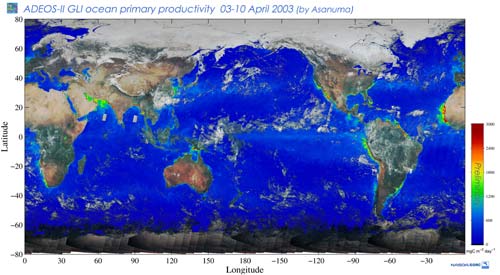 |
This image shows global primary productivity in the ocean estimated from the GLI high-level products (8-day average (from 3 to 10 April, 2003)). Primary productivity in the ocean means the amount of carbon per unit time and area that phytoplankton takes up and fixes as carbon dioxide in sea water by photosynthesis using sunlight and nutrients such as nitrogen and phosphate.
Primary productivity is remarkably high in mid-high latitude coastal regions. Coastal regions are known as high primary productivity regions throughout the year, in contrast to open sea regions. High primary productivity in coastal regions results from nutrient-rich water from the inflow of river water and coastal upwelling (upward flow in water) caused by ocean currents along the shore.
High primary productivity in open sea regions extends over a long and slender area along the equator from offshore Peru. It is also widespread from 30 to 40°N in the Pacific and Atlantic Oceans. A high primary productivity region along the equator corresponds to an equatorial upwelling zone, and this region is a large nutrient input due to the upward flow caused by the east-west trade winds. As a result, phytoplankton concentrations are higher than in adjacent water, so primary productivity is high.
At mid-high latitude regions, April is the phytoplankton bloom season (representing the greatest increase in phytoplankton of the year). The phytoplankton bloom in spring is caused by the increase in solar radiation from winter to spring. We suggest that high primary productivity near 30 to 40°N in the Pacific and Atlantic Oceans resulted from the influence of a phytoplankton bloom in April. Understanding the mechanisms of primary productivity in the ocean is very important for clarifying carbon cycles in the ocean relevant to global warming. It is also important for protecting and managing marine resources since phytoplankton plays a significant role in feeding habitats for marine commercial resources such as sardine and tuna through a marine food web.
 See the details of GLI ocean products See the details of GLI ocean products |




